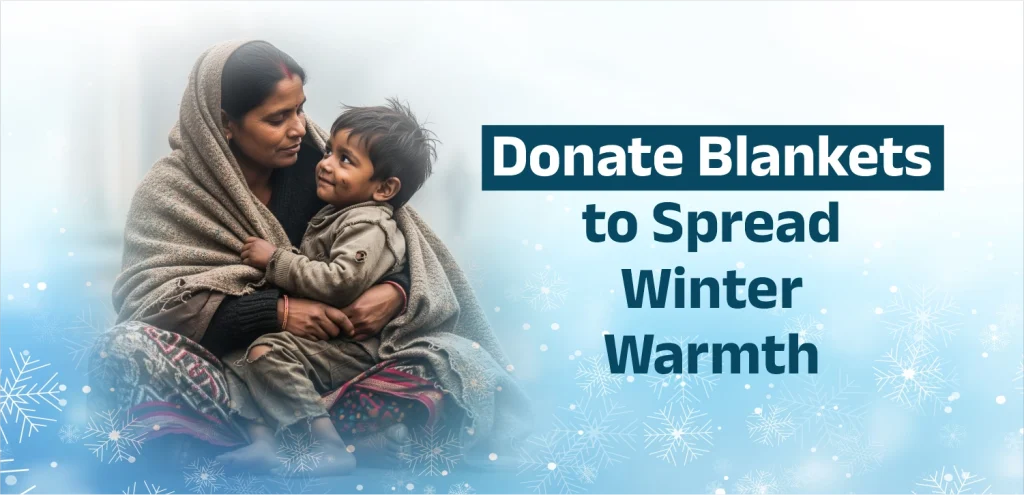As winter settles across India, the critical need to donate blankets is immediately apparent. The drop in temperature brings more than just seasonal discomfort—it brings life-threatening challenges for millions. Cold waves sweep through northern plains, hilly regions, and even southern cities, plunging temperatures to uncomfortable and often dangerous lows. For families living in poverty, the elderly in remote villages, and children in underserved communities, the absence of warm clothing turns each night into a struggle for survival.
Many households lack basic winter essentials. Without blankets or warm garments, people are exposed to health risks such as hypothermia, respiratory infections, and joint pain. These conditions disproportionately affect the most vulnerable—children, senior citizens, and those with disabilities. In such circumstances, a simple blanket becomes a shield against the cold, offering not just physical warmth but emotional comfort and dignity.
The Impact of Donating Winter Warmth
Donating blankets during winter is one of the most effective ways to support communities in need; we can call it winter seva. A single blanket can improve sleep quality, boost immunity, and reduce medical expenses for low-income families. Schools report better attendance when students arrive warm and focused, while elders find relief from chronic pain. The act of giving also restores hope—imagine a differently-abled person finally sleeping through the night without shivering, or a child studying late into the evening wrapped in warmth.
Last winter, thousands of individuals received woolen covers that preserved body heat and lifted spirits. These donations reached slums, remote villages, shelters, and rehabilitation centers, transforming lives one layer at a time. Beyond the immediate physical benefits, blanket donations foster emotional resilience. They remind recipients that someone cares, that they are not alone in their struggle.
How to Donate Blankets Effectively
Contributing to a blanket donation campaign is simple and impactful. You can choose to:
- Donate Funds: Support trusted organizations that purchase and distribute high-quality blankets.
- Give Physical Items: Drop off gently used or new blankets at local collection centers.
- Use Online Platforms: Select donation amounts, complete secure payments, and track deliveries to recipients.
If you’re looking to amplify your impact, consider organizing a blanket drive. Gather friends, colleagues, or neighbors to collect and distribute winter essentials. Promote the initiative through social media, set up drop-off points, and encourage participation. Businesses can integrate blanket donations into their corporate social responsibility (CSR) programs, fostering team spirit while extending warmth to underserved communities.
Quality matters when donating. Choose thick, durable materials that retain heat and meet winter standards. Trusted donation channels often conduct quality checks to ensure every item provides lasting comfort. A well-made blanket can serve multiple purposes—used as bedding in winter, floor covers in summer, or extra layers during monsoons.
The Lasting Legacy of Giving
Blanket donations offer year-round utility and long-term impact. While the need peaks in winter, these items continue to serve families across changing seasons. Medical research confirms that maintaining core body temperature reduces stress on the immune system. Cold exposure elevates cortisol levels, weakening immunity and increasing susceptibility to illness. Your donation acts as preventive healthcare for entire communities.
There are also financial benefits to giving. Contributions often qualify for tax exemptions under relevant sections, and donors receive certificates promptly. This dual advantage—helping others while saving on taxes—makes giving even more rewarding.
Modern technology has made it easier than ever to donate. If you’re unable to visit a donation center, consider gifting blankets online. Select the number of blankets, add a personal message, and receive photos of recipients wrapped in your kindness. This virtual approach fits busy schedules while creating meaningful connections.
Real stories highlight the transformative power of your generosity. A young girl in a tribal hamlet used her new blanket to study without distraction from the cold. An elderly widow shared how warmth eased her arthritis pain for the first time in years. These moments of change begin with a simple act of kindness, such as the choice to donate blankets.
Sharing your giving journey online can inspire others. Use hashtags to spread awareness, tag friends, and post recipient smiles. One person’s choice to donate often motivates dozens more to join the winter warmth movement.
Make This Winter Count
This winter, choose to be the reason someone sleeps peacefully. Choose to be the warmth in someone’s life. Donate a blanket and wrap hope around those who need it most. Small actions create big warmth—start today and change a life forever.
Frequently Asked Questions (FAQs)
1. What types of blankets are best for donation?
Thick, durable blankets made of wool, fleece, or heavy cotton are ideal for winter donations. They should be clean, in good condition, and capable of retaining body heat. Avoid donating torn, thin, or heavily worn-out items.
2. Can I donate used blankets?
Yes, gently used blankets in good condition are welcome. Ensure they are clean, free of stains or damage, and suitable for immediate use. If you’re unsure, ask yourself, “Would I be comfortable using this blanket myself?”
3. Where can I donate blankets?
You can donate through local NGOs, shelters, community centers, or verified online platforms that run winter donation drives. Many organizations also offer doorstep pickup or drop-off locations for convenience.
4. Is my blanket donation eligible for tax benefits?
Yes, donations made through registered charitable organizations are often eligible for tax deductions under relevant sections of the Income Tax Act. Be sure to request a donation receipt for your records.
5. How can I involve others in a blanket donation drive?
Start by organizing a local campaign with friends, family, or colleagues. Use social media to spread the word, set up collection points, and partner with NGOs for distribution. Group efforts can significantly expand your impact and reach more people in need.







